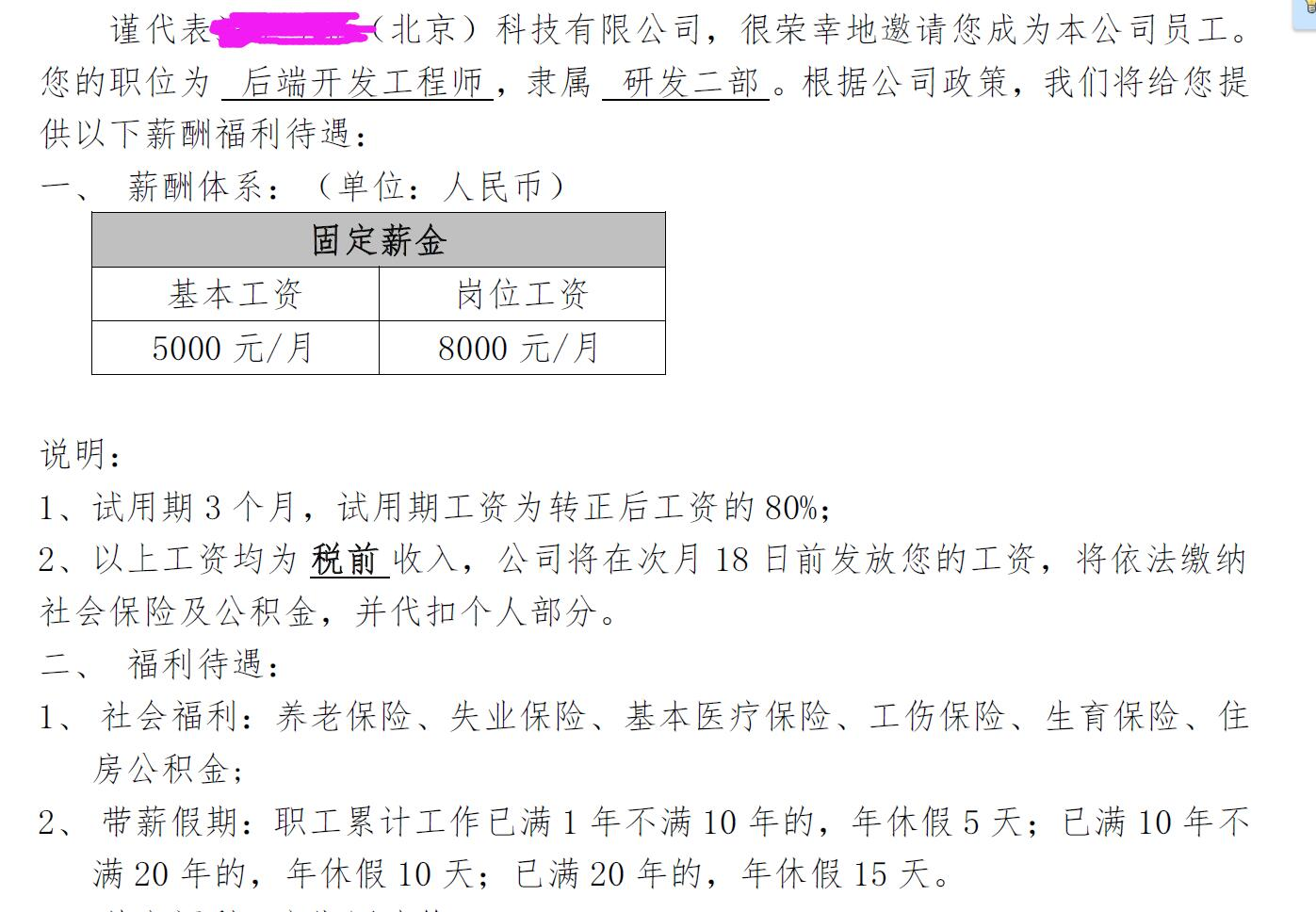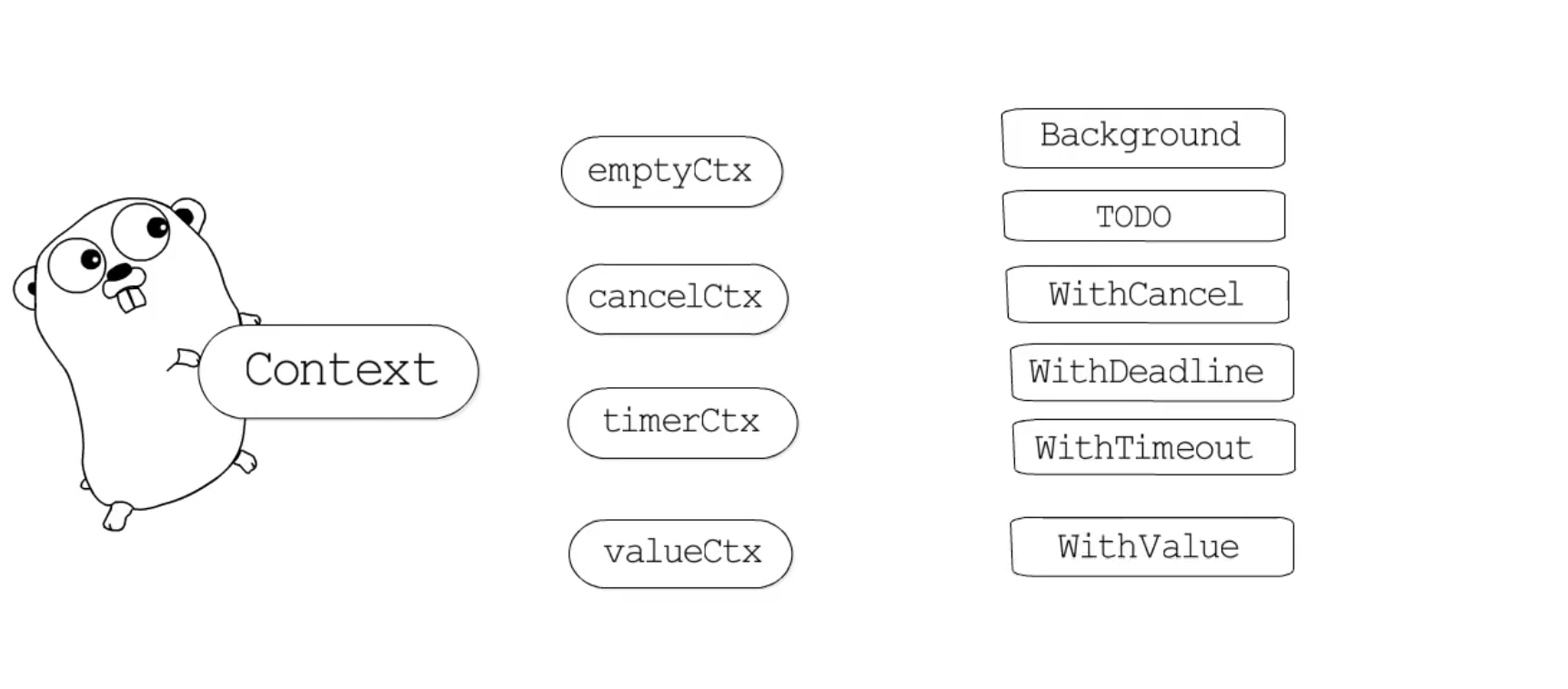实现一个小目标很开心的一件事,学习了一个月的后端拿到一个13k的offer,今年年底目标拿到一个30k的go方向offer。 好了回归正文,这篇文章是回答交流时一个老哥的问题,跟go的contex
 好了回归正文,这篇文章是回答交流时一个老哥的问题,跟go的context相关内容,上一篇(https://www.cnblogs.com/dojo-lzz/p/16183006.html)讲了一些基础知识,这一篇继续在并发处理上进行研究。主要是Go Context的使用、原理。因为时间和精力有限,所以文章中大量引用相关资料中的内容以及图片,再此致敬。
Go Context
React中Context主要用来跨组件传递一些数据,Go中Context其中一个作用也跟传递数据有关,不过是在goroutine中相互传递数据;Context的另一个作用在于可以便捷关闭被创建出来的goroutine。
在实际中当服务器端收到一个请求时,很可能需要发送几个请求去请求其他服务的数据,由于Go 语法上的同步阻塞写法,我们一般会创建几个goroutine并发去做一些事情;那么这时候很可能几个goroutine之间需要共享数据,还有当request被取消时,创建的几个goroutine也应该被取消掉。那么这就是Go Context的用武之地。
关于协程泄露:
一般main函数是主协程,主协程执行完毕后子协程也会被销毁;但是对于服务来说,主协程不会执行完毕就退出。
所以如果每个请求都自己创建协程,而协程有没有受到完毕信息结束信息,可能处于阻塞状态,这种情况下才会产生协程泄露
context包中核心是Context接口:
好了回归正文,这篇文章是回答交流时一个老哥的问题,跟go的context相关内容,上一篇(https://www.cnblogs.com/dojo-lzz/p/16183006.html)讲了一些基础知识,这一篇继续在并发处理上进行研究。主要是Go Context的使用、原理。因为时间和精力有限,所以文章中大量引用相关资料中的内容以及图片,再此致敬。
Go Context
React中Context主要用来跨组件传递一些数据,Go中Context其中一个作用也跟传递数据有关,不过是在goroutine中相互传递数据;Context的另一个作用在于可以便捷关闭被创建出来的goroutine。
在实际中当服务器端收到一个请求时,很可能需要发送几个请求去请求其他服务的数据,由于Go 语法上的同步阻塞写法,我们一般会创建几个goroutine并发去做一些事情;那么这时候很可能几个goroutine之间需要共享数据,还有当request被取消时,创建的几个goroutine也应该被取消掉。那么这就是Go Context的用武之地。
关于协程泄露:
一般main函数是主协程,主协程执行完毕后子协程也会被销毁;但是对于服务来说,主协程不会执行完毕就退出。
所以如果每个请求都自己创建协程,而协程有没有受到完毕信息结束信息,可能处于阻塞状态,这种情况下才会产生协程泄露
context包中核心是Context接口:
type Context interface { Deadline() (deadline time.Time, ok bool) Done() <-chan struct{} Err() error Value(key interface{}) interface{} }
- Deadline 方法返回当前Context被取消的时间,也就是完成工作的截止时间(deadline);
- Done方法需要返回一个channel,这个Channel会在当前工作完成或者上下文被取消之后关闭,可以在子goroutine中利用select进行监控,来回收子goroutine;多次调用Done方法会返回同一个Channel;
// Done is provided for use in select statements: // // Stream generates values with DoSomething and sends them to out // // until DoSomething returns an error or ctx.Done is closed. // func Stream(ctx context.Context, out chan<- Value) error { // for { // v, err := DoSomething(ctx) // if err != nil { // return err // } // select { // case <-ctx.Done(): // return ctx.Err() // case out <- v: // } // } // } // See https://blog.golang.org/pipelines for more examples of how to use // a Done channel for cancellation.
- Err方法会返回当前Context结束的原因,它只会在Done返回的Channel被关闭时才会返回空值:
- 如果当前Context被取消就会返回Canceled错误;
- 如果当前Context超时就会返回DeadlineExceeded错误;
- Value 方法会从Context中返回键对应的值,对于同一个上下文来说,多次调用Value并传入相同的Key会返回相同的结果,该方法仅用于传递跨API和进程间跟请求域的数据。
// // Package user defines a User type that's stored in Contexts. // package user // import "context" // // User is the type of value stored in the Contexts. // type User struct {...} // // // key is an unexported type for keys defined in this package. // // This prevents collisions with keys defined in other packages. // type key int // // userKey is the key for user.User values in Contexts. It is // // unexported; clients use user.NewContext and user.FromContext // // instead of using this key directly. // var userKey key // // NewContext returns a new Context that carries value u. // func NewContext(ctx context.Context, u *User) context.Context { // return context.WithValue(ctx, userKey, u) // } // // FromContext returns the User value stored in ctx, if any. // func FromContext(ctx context.Context) (*User, bool) { // u, ok := ctx.Value(userKey).(*User) // return u, ok // }
ctx.Value(userKey).(*User)这里是Go语言中的类型断言(http://c.biancheng.net/view/4281.html)
value, ok := x.(T)
x 表示一个接口的类型,T 表示一个具体的类型(也可为接口类型)
该断言表达式会返回 x 的值(也就是 value)和一个布尔值(也就是 ok),可根据该布尔值判断 x 是否为 T 类型:
如果 T 是具体某个类型,类型断言会检查 x 的动态类型是否等于具体类型 T。如果检查成功,类型断言返回的结果是 x 的动态值,其类型是 T。
如果 T 是接口类型,类型断言会检查 x 的动态类型是否满足 T。如果检查成功,x 的动态值不会被提取,返回值是一个类型为 T 的接口值。
无论 T 是什么类型,如果 x 是 nil 接口值,类型断言都会失败。
在context包中Context一个接口有四个具体实现和六个函数:
 emptyCtx
emptyCtx本质是一个整型类型,他对Context接口的实现,非常简单,其实是什么也没做,都是一堆空方法:
emptyCtx
emptyCtx本质是一个整型类型,他对Context接口的实现,非常简单,其实是什么也没做,都是一堆空方法:
// An emptyCtx is never canceled, has no values, and has no deadline. It is not // struct{}, since vars of this type must have distinct addresses. type emptyCtx int func (*emptyCtx) Deadline() (deadline time.Time, ok bool) { return } func (*emptyCtx) Done() <-chan struct{} { return nil } func (*emptyCtx) Err() error { return nil } func (*emptyCtx) Value(key any) any { return nil } func (e *emptyCtx) String() string { switch e { case background: return "context.Background" case todo: return "context.TODO" } return "unknown empty Context" } var ( background = new(emptyCtx) todo = new(emptyCtx) )
这里的String方法挺有意思,因为下面中可以看到background和todo都是一个emptyContext所以,这里直接case进行对比background和todo;
// Background returns a non-nil, empty Context. It is never canceled, has no // values, and has no deadline. It is typically used by the main function, // initialization, and tests, and as the top-level Context for incoming // requests. func Background() Context { return background } // TODO returns a non-nil, empty Context. Code should use context.TODO when // it's unclear which Context to use or it is not yet available (because the // surrounding function has not yet been extended to accept a Context // parameter). func TODO() Context { return todo }
cancelCtx 通过WithCancel来创建的就是cancelCtx,WithCancel返回一个ctx和cancel方法,通过调用cancel方法,可以将Context取消,来控制协程,具体看下面例子: 在这个例子中,通过defer调用cancel,在FixLeakingByContext函数结束时去掉context,在CancelByContext中配合select和context的done方式来使用,可以避免协程资源没有被回收引起的内存泄露。
func FixLeakingByContex() { //创建上下文用于管理子协程 ctx, cancel := context.WithCancel(context.Background()) //结束前清理未结束协程 defer cancel() ch := make(chan int) go CancelByContext(ctx, ch) go CancelByContext(ctx, ch) go CancelByContext(ctx, ch) // 随机触发某个子协程退出 ch <- 1 } func CancelByContext(ctx context.Context, ch chan (int)) int { select { case <-ctx.Done(): //fmt.Println("cancel by ctx.") return 0 case n := <-ch : return n } }
看下WithCancel的源码:
func WithCancel(parent Context) (ctx Context, cancel CancelFunc) { if parent == nil { panic("cannot create context from nil parent") } // WithCancel通过一个父级Context来创建出一个cancelCtx c := newCancelCtx(parent) // 调用propagateCancel根据父级context的状态来关联cancelCtx的cancel行为 propagateCancel(parent, &c) // 返回c和一个方法,方法中调用c.cancel并传递Canceled变量 return &c, func() { c.cancel(true, Canceled) } } func newCancelCtx(parent Context) cancelCtx { return cancelCtx{Context: parent} } var Canceled = errors.New("context canceled")
WithCancel通过一个父级Context来创建出一个cancelCtx,然后调用propagateCancel根据父级context的状态来关联cancelCtx的cancel行为(感觉这里不应该叫propagate,冒泡一般理解是自下向上,这个函数明显是自下向上,应该叫cascade更为合理一些)。随后返回c和一个方法,方法中调用c.cancel并传递Canceled变量(其实是一个error实例); cancelCtx是WidthDeadline和WidthTimeout的基石,所以cancelCtx的实现相对复杂,我们重点讲解。 newCancelCtx方法可以看到是创建了一个cancelCtx实例
func newCancelCtx(parent Context) cancelCtx { return cancelCtx{Context: parent} }
我们也看下cancelCtx的定义:
// A cancelCtx can be canceled. When canceled, it also cancels any children // that implement canceler. type cancelCtx struct { Context // 内嵌结构体 mu sync.Mutex // protects following fields done atomic.Value // of chan struct{}, created lazily, closed by first cancel call children map[canceler]struct{} // set to nil by the first cancel call err error // set to non-nil by the first cancel call }
cancelCtx有一个内嵌的Context类型,实际存储的都是父级上下文对象,还有四个独立的字段:
- mu:一个互斥量,用来加锁保证某些操作的线程安全性
- done:atomic.Value一个可以对任意类型进行原子型操作的结构;提供Load和Store方法;看Go源码这里存的是一个struct{}类型的channel
- children:一个key为canceler值为struct{}的map类型;
- err:存放error的字段
// A canceler is a context type that can be canceled directly. The // implementations are *cancelCtx and *timerCtx. type canceler interface { cancel(removeFromParent bool, err error) Done() <-chan struct{} }
下面看下propagateCancel,据父级context的状态来关联cancelCtx的cancel行为
// propagateCancel arranges for child to be canceled when parent is. func propagateCancel(parent Context, child canceler) { // 如果父元素的Done方法返回为空,也就是说父context是emptyCtx // 直接返回,因为父上下文不会做任何处理 done := parent.Done() if done == nil { return // parent is never canceled } // 如果父上下文不是emptyCtx类型,使用select来判断一下父上下文的done channel是不是已经被关闭掉了 // 关闭则调用child的cancel方法 // select其实会阻塞,但这里给了一个default方法,所以如果父上下文的done channel没有被关闭则继续之心后续代码 // 这里相当于利用了select的阻塞性来做if-else判断 select { case <-done: // parent is already canceled child.cancel(false, parent.Err()) return default: } // parentCancelCtx目的在于寻找父上下文中最底层的cancelCtx,因为像timerCtx等会内嵌cancelCtx if p, ok := parentCancelCtx(parent); ok { // 如果找的到,就把最内层的cancelCtx跟child的设置好关联关系 // 这里要考虑到多线程环境,所以是加锁处理 p.mu.Lock() if p.err != nil { // 如果祖先cancelCtx已经被取消了,那么也调用child的cancel方法 // parent has already been canceled child.cancel(false, p.err) } else { // 这里设置内层cancelCtx与child的父子层级关系 if p.children == nil { p.children = make(map[canceler]struct{}) } p.children[child] = struct{}{} } p.mu.Unlock() } else { // 这里代表没有找到祖先cancelCtx,单启了一个协程来进行监听(因为select是阻塞的),如果父上下文的done 关闭了,则子上下文取消 // goroutines在别的地方代码中没有使用,不知道为什么要做增加操作,看源码英文解释也是为了测试使用 // 单独的协程会在阻塞完毕后被GC回收,不会有泄露风险 atomic.AddInt32(&goroutines, +1) go func() { select { case <-parent.Done(): child.cancel(false, parent.Err()) case <-child.Done(): } }() } }
里面调用了一个parentCancelCtx函数,这个函数比较晦涩,市面上资料也还没有人去仔细研究,这里我来讲解一下; 这个函数中最重要的就是12行,通过cancelCtxKey获取最近的内嵌cancelCtx;然后让在propagateCancel中设置内嵌cancelCtx与child的关联关系; 同时这个函数也考虑了几种情况,如果parent的done已经是closedchan或者是nil那么没必要去拿内层的cancelCtx来建立层级关系,直接用parent本身与child做好关联cancel即可。这是9-11行代码干的事。 16行-19行,看源码解释是如果这个内嵌cancelCtx可能加了一些自定义方法,比如复写了Done或者cancel,那么它就不是这里的timerCtx、cancelCtx或者valueCtx,这种情况下用户自己负责处理;放到propagateCancel这个函数中就是把parent和child直接关联起来,不建立层级关系。及时子child自己cancel也不去跟parent的children有什么关联。
// parentCancelCtx returns the underlying *cancelCtx for parent. // It does this by looking up parent.Value(&cancelCtxKey) to find // the innermost enclosing *cancelCtx and then checking whether // parent.Done() matches that *cancelCtx. (If not, the *cancelCtx // has been wrapped in a custom implementation providing a // different done channel, in which case we should not bypass it.) func parentCancelCtx(parent Context) (*cancelCtx, bool) { done := parent.Done() if done == closedchan || done == nil { return nil, false } p, ok := parent.Value(&cancelCtxKey).(*cancelCtx) if !ok { return nil, false } pdone, _ := p.done.Load().(chan struct{}) if pdone != done { return nil, false } return p, true }
那么这里就有了一个问题,propagateCancel函数中一定建立parent和child的children关系么?我理解是不用的,因为这个else部分代码我理解完全可以实现父级上下文结束后,child也进行取消;我猜这里尽量建立children的map关系,是如果不这么做就要起一个goroutine来处理,相当于一个监护线程,goroutine资源的消耗以及调度成本,比单纯的children层级关系更大,所以这里尽力使用map结构来建立层级关系。这也可以看到作者在写代码时候还是很花心思去考量各种情况的。
} else { // 这里代表没有找到祖先cancelCtx,单启了一个协程来进行监听(因为select是阻塞的),如果父上下文的done 关闭了,则子上下文取消 // goroutines在别的地方代码中没有使用,不知道为什么要做增加操作,看源码英文解释也是为了测试使用 // 单独的协程会在阻塞完毕后被GC回收,不会有泄露风险 atomic.AddInt32(&goroutines, +1) go func() { select { case <-parent.Done(): child.cancel(false, parent.Err()) case <-child.Done(): } }() }接下来看下cancelCtx中Value、Done、Err以及私有方法cancel的实现; Value方法 源码如下
func (c *cancelCtx) Value(key any) any { if key == &cancelCtxKey { return c } return value(c.Context, key) }首先要介绍下cancelCtxKey,这是一个context包中的私有变量,当对cancelCtx调用Value方法并用这个key作为参数时,返回cancelCtx本身; 如果没有找到则是调用的context包中的私有方法value,来在父级上下文中key对应的值; 这个方法首先进行类型断言,判断Context是否是valueCtx、cancelCtx、timerCtx以及emptyCtx等;根据不同的类型做不同处理,比如cancelCtx和timerCtx先进行cancelCtxKey判断,emptyCtx直接返回nil,valueCtx则判断是否是自己实例化时候传入的key,否则就去自己的内层context也就是parent层级上冒泡获取对应的值。
func value(c Context, key any) any { for { switch ctx := c.(type) { case *valueCtx: if key == ctx.key { return ctx.val } c = ctx.Context case *cancelCtx: if key == &cancelCtxKey { return c } c = ctx.Context case *timerCtx: if key == &cancelCtxKey { return &ctx.cancelCtx } c = ctx.Context case *emptyCtx: return nil default: return c.Value(key) } } }
Done方法
func (c *cancelCtx) Done() <-chan struct{} { // 返回atomic.Value中存储的值 d := c.done.Load() if d != nil { // atomic.Value类型的Load方法返回的是ifaceWords类型,所以这里是利用了类型断言 // 把ifaceWords类型转换为 struct类型的chan return d.(chan struct{}) } // 这里是并发场景要考虑的问题,因为会存在多个线程并发进行的过程,所以不一定哪个goroutine就对c.done进行了修改 // 所以这里不能直接像单线程一样,if d!=nil else。。。;首先得抢锁。 c.mu.Lock() defer c.mu.Unlock() d = c.done.Load() // 上面抢锁的过程可能抢到了,也可能没抢到,所以到这里是抢到了锁,但是c.done未必还是nil; // 所以这里要再次做判断 if d == nil { d = make(chan struct{}) c.done.Store(d) } return d.(chan struct{}) }看到上面锁的过程,发现并发情况的处理要比js这种单线程考虑的多得多。并发对一个变量的处理不能简单的if-else;要结合锁、CAS、原子操作一起考虑(对于atomic.Value中的ifaceWords的部分可以看这篇文章:https://www.cnblogs.com/dojo-lzz/p/16183006.html中原子操作部分)。 Err方法
func (c *cancelCtx) Err() error { c.mu.Lock() err := c.err c.mu.Unlock() return err }这个方法比较简单只是获取了cancelCtx的err属性,这个属性在cancel中会会被设置。 cancel方法
func (c *cancelCtx) cancel(removeFromParent bool, err error) { if err == nil { panic("context: internal error: missing cancel error") } // 因为后面要对c.err和c.done进行更新,所以这里要抢锁 c.mu.Lock() if c.err != nil { // if这部分放到锁的外部是否可以?看起来是可以的,但是如果放到外面,if判断不通过此时c.err为nil // 接着进行抢锁,那么在抢到锁之后仍然要对c.err判断是否还是nil,才能进行更新 // 因为在抢锁过程中,可能c.err已经被某个协程修改了 // 所以把这部分放到锁之后是合理的。 c.mu.Unlock() return // already canceled } c.err = err // 赋值 d, _ := c.done.Load().(chan struct{}) // 读取done的值 if d == nil { // 如果done为nil,就把一个内部的closedchan存入c.done中; // closedchan是一个channel类型,在context包的init函数中就会把它close掉 c.done.Store(closedchan) } else { close(d) } // 遍历c的children调用他们的cancel; for child := range c.children { // NOTE: acquiring the child's lock while holding parent's lock. child.cancel(false, err) } c.children = nil c.mu.Unlock() // 这部分没有在锁的代码中,是因为函数中会自己加锁? if removeFromParent { removeChild(c.Context, c) } }代码最后调用removeChild方法,这部分为什么没在c.mu锁中,我猜是因为这个函数的代码自己会进行锁的处理。
// removeChild removes a context from its parent. func removeChild(parent Context, child canceler) { p, ok := parentCancelCtx(parent) if !ok { return } p.mu.Lock() if p.children != nil { delete(p.children, child) } p.mu.Unlock() }可以看到代码中的锁部分,是在第7行开始的,那么为什么parentCancelCtx没有被包含在锁中,这里猜测下,因为parentCancelCtx的主要目的是为了获取父级上下文内层的cancelCtx,而这个值是在实例化时候就已经确定的,这里只是读取所以可以不用放在互斥锁的临界区代码中,避免性能浪费。 接下来就是p.mu来抢锁,完成对层级结构的接触。 timerCtx WithTimeout和WithDeadline创建的都是timerCtx,timerCtx内部内嵌了cancelCtx;
type timerCtx struct { cancelCtx timer *time.Timer // Under cancelCtx.mu. deadline time.Time }因为内嵌了cancelCtx,而cancelCtx实现了Done、Value、Err以及cancel(私有)方法,所以timerCtx上也可以直接调用这几个方法(http://c.biancheng.net/view/72.html);cancelCtx并未实现Deadline方法,但是emptyCtx实现了,如果他的父级上下文是emptyCtx那么cancelCtx也可以调用Deadline方法。 看完cancelCtx的方法之后,对比起来timerCtx的方法都比较简单,不做过多解释
func (c *timerCtx) Deadline() (deadline time.Time, ok bool) { return c.deadline, true } func (c *timerCtx) String() string { return contextName(c.cancelCtx.Context) + ".WithDeadline(" + c.deadline.String() + " [" + time.Until(c.deadline).String() + "])" } func (c *timerCtx) cancel(removeFromParent bool, err error) { c.cancelCtx.cancel(false, err) if removeFromParent { // Remove this timerCtx from its parent cancelCtx's children. removeChild(c.cancelCtx.Context, c) } c.mu.Lock() if c.timer != nil { c.timer.Stop() c.timer = nil } c.mu.Unlock() }可以看到cancel方法中先调用了内嵌的cancelCtx的cancel方法;然后利用cancelCtx的互斥锁抢锁来对c.timer进行操作修改;cancel方法第13-16行需要注意,因为withDeadline在创建时把parent和timerCtx建立了层级关系,所以这里根据条件进行移除操作。 下面来看下withDeadline函数:
func WithDeadline(parent Context, d time.Time) (Context, CancelFunc) { if parent == nil { panic("cannot create context from nil parent") } // 如果parent的deadline小于当前时间,直接创建cancelCtx,里面会调用propagateCancel方法 // 来根据父上下文状态进行处理 if cur, ok := parent.Deadline(); ok && cur.Before(d) { // The current deadline is already sooner than the new one. return WithCancel(parent) } // 创建timerCtx,这里可以看到cancelCtx是私有变量,而cancelCtx中的Context字段是公有变量 c := &timerCtx{ cancelCtx: newCancelCtx(parent), deadline: d, } // 设置层级取消关联 propagateCancel(parent, c) dur := time.Until(d) // 如果已经超时直接取消 if dur <= 0 { c.cancel(true, DeadlineExceeded) // deadline has already passed return c, func() { c.cancel(false, Canceled) } } c.mu.Lock() defer c.mu.Unlock() // 如果没有超时并且没有被调用过cancel,那么设置timer,超时则调用cancel方法; if c.err == nil { c.timer = time.AfterFunc(dur, func() { c.cancel(true, DeadlineExceeded) }) } return c, func() { c.cancel(true, Canceled) } }了解上面内容之后,WithTimeout就很简单了,只是调用了WidthDeadline方法
func WithTimeout(parent Context, timeout time.Duration) (Context, CancelFunc) { return WithDeadline(parent, time.Now().Add(timeout)) }
valeCtx 这个结构体相对简单,有一个Context公共变量,一个任意类型的key和任意类型的any:
type valueCtx struct {
Context
key, val any
}
withValue方法也比较简单,这里就不做过多介绍
func WithValue(parent Context, key, val any) Context { if parent == nil { panic("cannot create context from nil parent") } if key == nil { panic("nil key") } if !reflectlite.TypeOf(key).Comparable() { panic("key is not comparable") } return &valueCtx{parent, key, val} }
还有一个Value方法: 如果key与WithValue调用时相同,则返回对应的val,否则进入value方法,在内嵌的Context中查找key对应的值,这个方法上面介绍过,根据Context类型先做一些类型判断,来判断一些关键的key如cancelCtxKey,不然继续在内嵌Context中查找。
func (c *valueCtx) Value(key any) any { if c.key == key { return c.val } return value(c.Context, key) }
参考资料 本文大量引用了相关参考资料的图片和语言。版权问题请与我联系,侵删。
- 深入理解Go Context:https://article.itxueyuan.com/39dbvb
- context源码:https://github.com/golang/go/blob/master/src/context/context.go
- 聊一聊Go的Context上下文:https://studygolang.com/articles/28726
- go context详解:https://www.cnblogs.com/juanmaofeifei/p/14439957.html
- Go语言Context(上下文):http://c.biancheng.net/view/5714.html
- atomic原理以及实现:https://blog.csdn.net/u010853261/article/details/103996679
- atomic前世今生:https://blog.betacat.io/post/golang-atomic-value-exploration/

